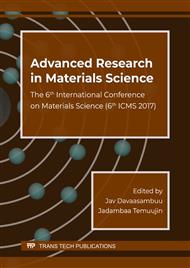[1]
R.G. Chaudhuri, S. Paria, Core/shell nanoparticles: classes, properties, synthesis mechanisms, characterization, and applications, Chem. Rev. 112. 4 (2012) 2373-2433.
DOI: 10.1021/cr100449n
Google Scholar
[2]
A.V. Nomoev et al., Structure and mechanism of the formation of core–shell nanoparticles obtained through a one-step gas-phase synthesis by electron beam evaporation, Beilstein journal of nanotechnology 6 (2015) 874-880.
DOI: 10.3762/bjnano.6.89
Google Scholar
[3]
A.V. Nomoev, S.P. Bardakhanov, Synthesis and structure of Ag-Si nanoparticles obtained by the electron-beam evaporation/condensation method, Technical Physics Letters, 38. 4 (2012) 375-378.
DOI: 10.1134/s1063785012040268
Google Scholar
[4]
Singh V. et al. Heterogeneous gas-phase synthesis and molecular dynamics modeling of Janus and core–satellite Si–Ag nanoparticles, J. of Physical Chemistry C, 118 (2014) 13869-13875.
DOI: 10.1021/jp500684y
Google Scholar
[5]
Zograf G. P. et al. Modeling of formation mechanism and optical properties of Si/Au core-shell nanoparticles, Proc. Int. Conf. Days on Diffraction, St. Petersburg, (2016) 460-463.
Google Scholar
[6]
V.S. Baidyshev, E.A. Kartavykh, Y. Ya. Gafner, Computer simulation of the formation of two-component Cu@Si nanoparticles from the gas phase, Proc. 6th Int. Symp. Nanomaterials and Nanotechnologies-VI, , Ulan-Ude, (2016) 67-70 (in Russian).
Google Scholar
[7]
Large-scale Atomic/Molecular Massively Parallel Simulator, LAMMPS, available at: http: /lammps. sandia. gov.
DOI: 10.21236/ada623365
Google Scholar
[8]
B. Jelinek, S. Groh, M.F. Horstemeyer, J. Houze, S.G. Kim, G.J. Wagner, A. Moitra, and M.I. Baskes, Modified embedded atom method potential for Al, Si, Mg, Cu, and Fe alloys, Phys. Rev. B. 85 (2012) 245102.
DOI: 10.1103/physrevb.85.245102
Google Scholar
[9]
M. Baskes, Modified embedded atom method calculations of interfaces, Report number: SAND–96-8484C, Sandia National Laboratories, Livermore, (1996).
Google Scholar
[10]
A. Stukowski, Visualization and analysis of atomistic simulation data with OVITO—the open visualization tool, Model. Simul. Mater. Sci. Eng. 18. 1 (2010) 015012.
DOI: 10.1088/0965-0393/18/1/015012
Google Scholar


